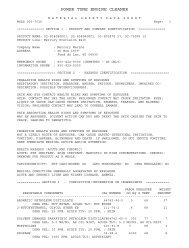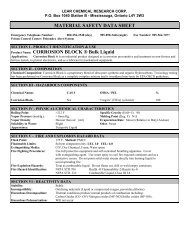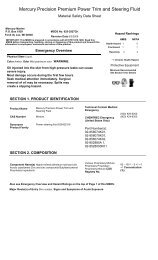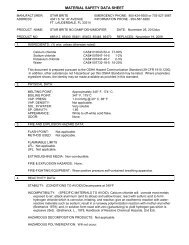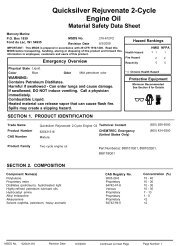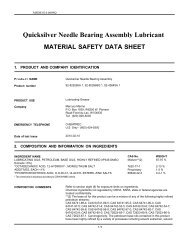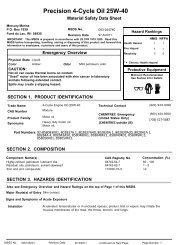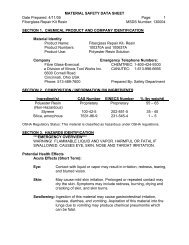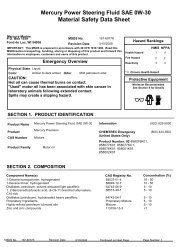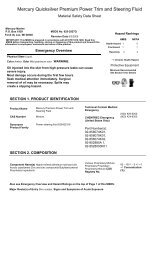Hand Held Flare Red Solas.pdf - Kellogg Marine Supply
Hand Held Flare Red Solas.pdf - Kellogg Marine Supply
Hand Held Flare Red Solas.pdf - Kellogg Marine Supply
You also want an ePaper? Increase the reach of your titles
YUMPU automatically turns print PDFs into web optimized ePapers that Google loves.
EMERGENCY TELEPHONE NUMBER: 613-996-6666<br />
MATERIAL SAFETY DATA SHEET<br />
PRODUCT NAME:<br />
SECTION I – IDENTIFICATION<br />
HAND HELD FLARE, RED (SOLAS 74/ 83 Qualified)<br />
CHEMICAL FAMILY: Not Applicable FORMULA: Mixed TRADE NAME: As above.<br />
DESCRIPTION: A signal which, when activated, produces a bright, red flame.<br />
CAS NO. N/A<br />
SECTION II - NORMAL HANDLING PROCEDURES<br />
PRECAUTIONS TO BE TAKEN IN HANDLING AND STORAGE (KEEP OUT OF REACH OF CHILDREN)<br />
Store in a cool, dry place away from all sources of ignition. Do not dismantle. Do not allow contents to touch eyes, skin or<br />
clothing. Do not ingest contents. Avoid breathing dust. Flush skin areas contacted with large amount of water.<br />
PROTECTIVE EQUIPMENT<br />
No protective equipment is required unless signals have broken open. In<br />
that case, those cleaning up should be protected from any dust by NIOSH<br />
approved goggles, respirators and gloves. Be sure all ignition sources are<br />
removed before beginning the cleaning operation.<br />
VENTILATION REQUIREMENTS<br />
None required.<br />
SECTION III - HAZARDOUS INGREDIENTS<br />
BASIC MATERIALS<br />
OSHA<br />
PEL<br />
LD 50 LC 50<br />
SIGNIFICANT EFFECTS<br />
Black Powder None Est. None Est. None Est. Dust and powder are explosive.<br />
Strontium Nitrate CAS# 10042-76-9 15 mg/m 3 540 mg/kg<br />
(rat)<br />
None Est.<br />
Oxidizer-supports combustion.<br />
Potassium Perchlorate<br />
CAS# 7778-74-7<br />
None Est. None Est. None Est. Strong oxidizer. Airborne dust is irritant.<br />
Magnesium CAS# 7439-95-4 None Est. None Est. None Est. Very strong fuel.<br />
Polyvinyl Chloride CAS# 9002-86-2 1 p.p.m. None Est. None Est. Avoid breathing dust.<br />
Binder None Est. None Est. None Est.<br />
SOLAS <strong>Red</strong> <strong>Hand</strong> <strong>Flare</strong> MSDS 52186 & 52286 Update: December 10, 2010 Sheet 1 of 3
SECTION IV - FIRE AND EXPLOSION HAZARD DATA<br />
Auto Ignition of Contents<br />
Black Powder- 400°F and above<br />
DOT<br />
CLASS<br />
1.4G<br />
U.N.<br />
NUMBER<br />
0191<br />
FLAMMABLE<br />
EXPLOSIVE<br />
LIMITS<br />
LOWER<br />
N/A<br />
EXTINGUISHING MEDIA: Water deluge. If a large number of signals are involved, explosion is possible.<br />
UPPER<br />
N/A<br />
SPECIAL FIRE HAZARD & FIRE FIGHTING PROCEDURES: Use NIOSH/MSHA approved self-contained breathing<br />
apparatus when this material is involved in a fire. If a large number of signals are involved, explosion is possible.<br />
THRESHOLD LIMIT VALUE: None established.<br />
SECTION V - HEALTH HAZARD DATA<br />
SYMPTOMS OF OVER EXPOSURE: As dust, contents can cause skin, eye and mucous membrane irritation or dermatitis.<br />
SKIN If exposed to signal contents, flush thoroughly with water.<br />
EYES If exposed to signal content flush at least 15 minutes with water. Call a physician.<br />
INGESTION If exposed to signal contents, give 1 to 2 glasses of water, induce vomiting. Call a physician.<br />
INHALATION If exposed to signal contents, move victim to fresh air. Call a physician if adverse symptoms persist.<br />
SECTION VI – TOXICOLOGY<br />
ACUTE ORAL LD 50: Not available.<br />
ACUTE INHALATION LC 50: No available data.<br />
TERATOGENICITY: No information available.<br />
ACUTE DERMAL LD 50: No available data.<br />
MUTAGENICITY No ingredients are known to be mutagens.<br />
NEUROTOXICITY: No information available.<br />
REPRODUCTIVE EFFECTS: No information available.<br />
CARCINOGENICITY Polyvinyl Chloride is suspected to be a carcinogen.<br />
PRINCIPAL ROUTES OF ABSORPTION: Inhalation or ingestion of contents.<br />
EFFECTS OF ACUTE EXPOSURE Can cause skin, eye and mucous membrane irritation, dermatitis and nausea.<br />
EFFECTS OF CHRONIC EXPOSURE Effect of dust - possible irritation of eyes, mucous membranes and skin. Dermatitis.<br />
SOLAS <strong>Red</strong> <strong>Hand</strong> <strong>Flare</strong> MSDS 52186 & 52286 Update: December 10, 2010 Sheet 2 of 3
SECTION VII - SPILL AND LEAKAGE PROCEDURES (Control Procedures)<br />
ACTION FORMATERIAL RELEASE OR SPILL<br />
Remove all sources of ignition. Contain spill. If significant amounts of dust are present, wear chemical safety goggles, Viton<br />
or Norfoil gloves, clothing designed to prevent or minimize skin contact and a NIOSH/MSHA approved dust respirator. Use<br />
non-static forming broom and dust pan to clean up dust.<br />
Undamaged signals may be picked up and put back into their original shipping containers or containers approved by local,<br />
state and federal authorities.<br />
WASTE DISPOSAL METHOD<br />
Disposal method of contaminated product and materials used in cleaning up spills will depend on the type and size of the<br />
spill. First remove the spilled materials and store in a manner to keep them away from ignition sources. Then contact local,<br />
state or federal safety specialists for information on disposal of the spilled material.<br />
SECTION VIII - SHIPPING DATA<br />
DOT CLASS 1.4G\<br />
P.G. : II<br />
Signal Devices, <strong>Hand</strong><br />
UN 0191<br />
Net Explosive Quantity: 0.28kg(0.62lb)/unit<br />
SECTION IX - REACTIVITY DATA<br />
STABLE X<br />
UNSTABLE<br />
HAZARDOUS<br />
POLYMERIZATION<br />
MAY OCCUR<br />
WILL NOT OCCUR X<br />
CONDITIONS TO AVOID<br />
Keep all sources of ignition away from the signal and ingredients. Do not remain in an area where the ingredients have<br />
become airborne as a dust without wearing an approved respirator.<br />
INCOMPATIBILITY (Material to avoid) Avoid exposure to moisture, strong acids, strong bases, acid chlorides and strong<br />
fuels.<br />
HAZARDOUS DECOMPOSITION PRODUCTS Carbon monoxide, Carbon dioxide, Nitrogen oxides, Magnesium oxides,<br />
Strontium oxides, Potassium Oxides.<br />
SECTION X - PHYSICAL DATA<br />
MELTING POINT: N/A VAPOR PRESSURE: N/A VOLATIZES: None<br />
BOILING POINT N/A SOLUBILITY IN WATER: N/A EVAPORATION RATE: N/A<br />
SPECIFIC GRAVITY (H 2 O = 1): N/A pH: N/A VAPOR DENSITY (Air = 1): N/A<br />
INFORMATION FURNISHED BY: CIL/ORION<br />
DATE: 26, October 2002<br />
DATE REVISED: December 10, 2010<br />
SOLAS <strong>Red</strong> <strong>Hand</strong> <strong>Flare</strong> MSDS 52186 & 52286 Update: December 10, 2010 Sheet 3 of 3



